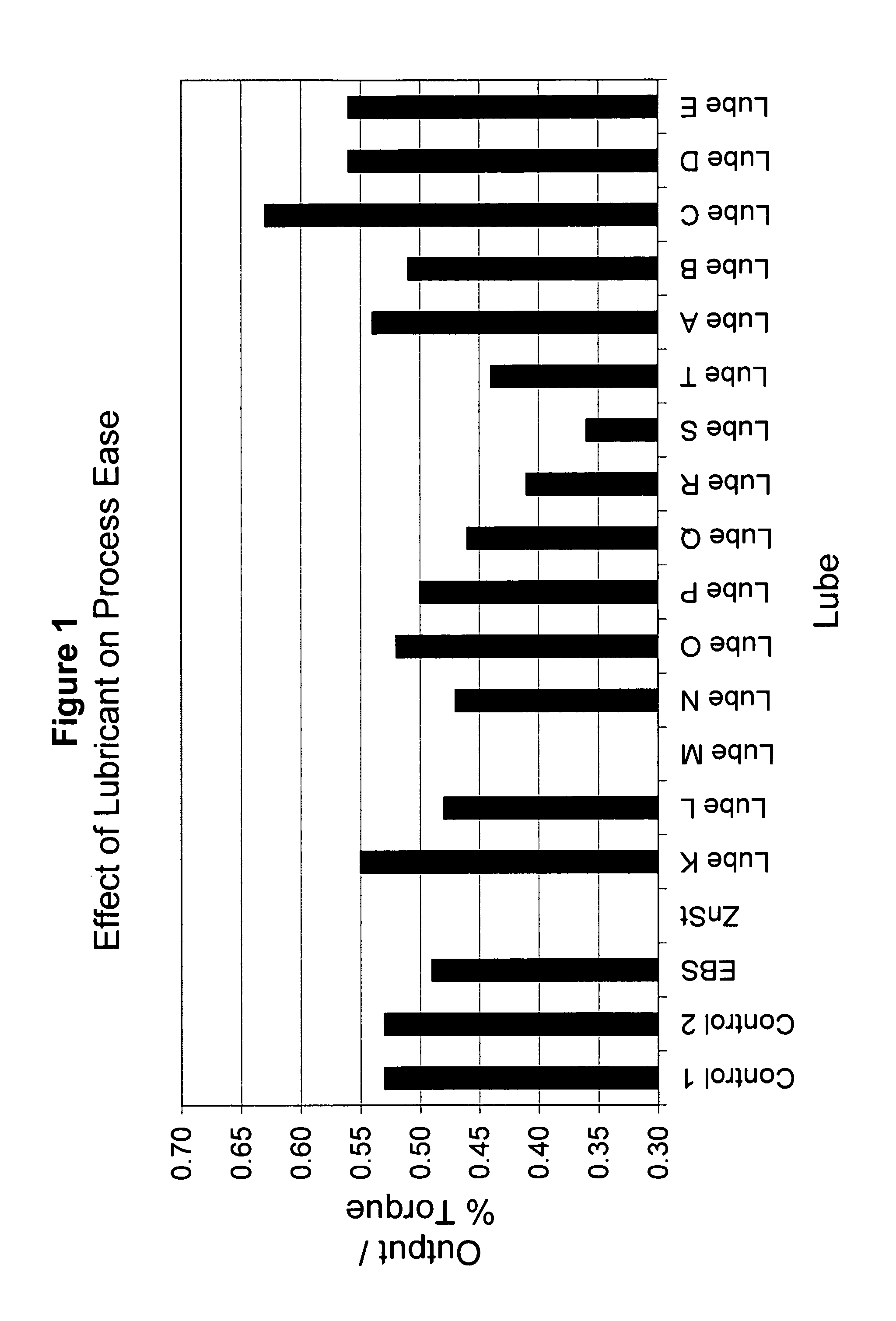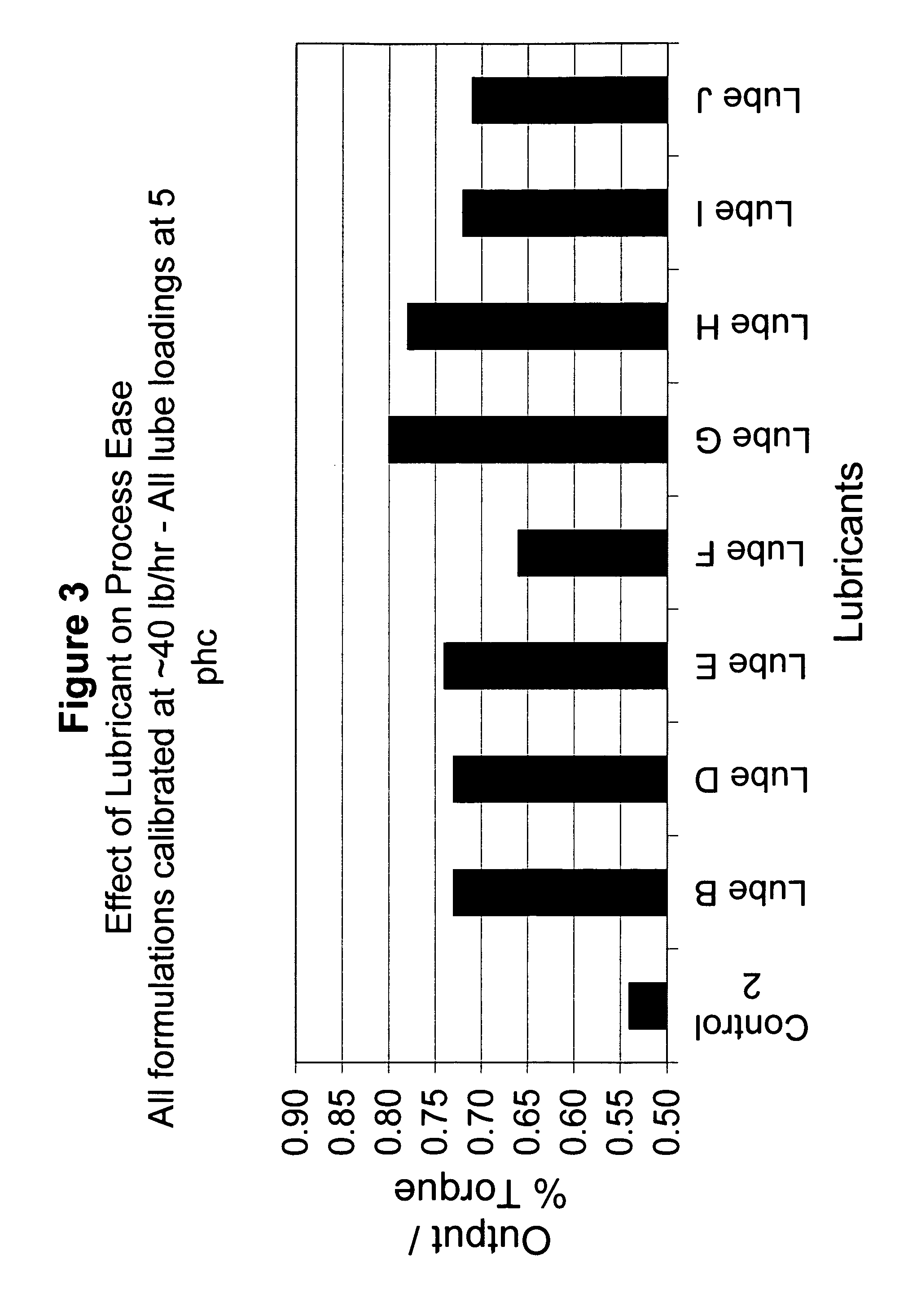Non-wood fiber plastic composites
a technology of non-wood fiber and composites, which is applied in the field of non-wood fiber plastic composites, can solve the problems that vinyl based thermoplastics are generally more difficult to process than olefin based thermoplastics, and achieve the effects of improving the dimensional stability of extruded profiles, reducing the temperature of the extruder, and increasing the output per percent extruder torqu
- Summary
- Abstract
- Description
- Claims
- Application Information
AI Technical Summary
Benefits of technology
Problems solved by technology
Method used
Image
Examples
example 1
HDPE-Oak Wood Flour
[0047]In this example, the extrudable composite contained 40% HDPE (Petrothene reactor powder (Equistar® LB0100-00) and 60% Oak 4037 (40 mesh) available from American Wood Fibers of Schofield, Wis. The control lubricants and the lubricants in the following tables were added to the extrudable composite in amount of at 5 phc (parts per hundred) based on total HDPE / Oak Flour.
[0048]The control lubricants consisted of EBS, ZnSt, and mixtures thereof. Composites were made using EBS alone, ZnSt alone, a mixture of approximately 1:1 of EBS and ZnSt (designated as “one pack”), and EBS and ZnSt added separately to the composite (designated “mixed separately”).
[0049]Table 1 shows the lubricants which are within the scope of the instant invention. Those in Table 2 are for comparative purposes:
[0050]
TABLE 1(Lubricants of the Invention)Lubricant SystemIngredientsAPOE1 15 di(2-hydroxyethyl-)5,5DMH distearateBPOE 15 di(2-hydroxylethyl-)5,5DMH monooleateCEthylene Bis (C8 / 10) amide...
example 2
HDPE-Pine Wood Flour
[0057]The extrudable composite in this example contained 40% of the same HDPE reactor powder as used in Example 1, 60% Pine 402050 (40 mesh) available from American Wood Fibers of Schofield, Wis., and 6 phc of Polar Minerals 9610 talc, available from Polar Minerals of Mentor, Ohio. A number of the better lubes in the foregoing HDPE-Oak composites were evaluated in the HDPE-Pine Flour composite. The extruder speed for these runs was 175 rpm with the feed rate set at 16 kg per hour. The control lubricant package for these formulations contained 1 phc EBS and 2 phc ZnSt as a one pack system (designated as “Control 3”) and as mixed separately (designated as “Control 4”).
[0058]The process ease results are shown in FIG. 5. They are similar to those in the HDPE-Oak formulations. The one pack lube and the EBS and ZnSt added separately, within experimental error, had the same process ease value. Lubes A, B, D and E had higher process ease values than the controls and Comp...
example 3
[0062]The process of the present invention was carried with an extrudable composition containing straw (an agricultural residue). An extrudable composition containing 60% straw strained through a 40 mesh screen and 40% HDPE without any lubricant was extruded. The extruded product was not coherent.
[0063]The procedure was repeated with 3 phc each of EBS and ZnSt, mixed separately. The product produced was coherent. These data show that a composite containing an agricultural waste product, EBS and ZnSt form a viable product which can be extruded to make lumber-like products.
PUM
| Property | Measurement | Unit |
|---|---|---|
| temperature | aaaaa | aaaaa |
| wt. % | aaaaa | aaaaa |
| pressure | aaaaa | aaaaa |
Abstract
Description
Claims
Application Information
 Login to View More
Login to View More - R&D
- Intellectual Property
- Life Sciences
- Materials
- Tech Scout
- Unparalleled Data Quality
- Higher Quality Content
- 60% Fewer Hallucinations
Browse by: Latest US Patents, China's latest patents, Technical Efficacy Thesaurus, Application Domain, Technology Topic, Popular Technical Reports.
© 2025 PatSnap. All rights reserved.Legal|Privacy policy|Modern Slavery Act Transparency Statement|Sitemap|About US| Contact US: help@patsnap.com



